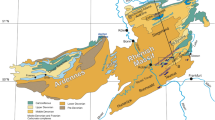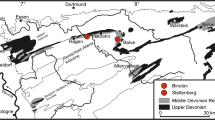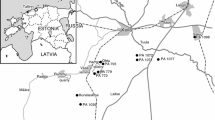Summary
The late Triassic succession of the Asher-Atlit 1 borehole is over 1000 m thick, and is composed of reefal and associated facies interbedded with volcanics of Norian age. Only borehole cuttings are available. Microfacies classification and cement stratigraphy determined by optical and CL microscopy, allowed discrimination of six episodes of reef establishment, progradation, shallowing, and termination. Organic buildups are constructed of reef-building biota (sponges, possible corals, encrusting organisms) typical for the late Triassic of the Tethys. Reef-associated facies include fore-slope, central reef, ooid shoal, lagoonal, and supratidal environments. Cement zoning patterns trace diagenetic signatures which range from early neomorphic skeletal replacements and original marine cements, via characteristic burial sequences; depositional and diagenetic sequences are terminated by marginal marine intra- or supratidal conditions, and subaerial exposure with pedogenic overprints. Volcanic episodes tend to be associated with termination of carbonate sedimentation episodes, while volcanic quiescence and subsidence permit vertical progradation of reefal and associated facies. The depositional and progradational environment, rapid rate of sedimentation, periodicity, association with volcanics, and regional considerations, suggest a depositional setting on the rifted shelf-margin of the nascent Neo-Tethys, with a possible eustatic overprint.
Similar content being viewed by others
References
Amieux, P., Bernier, P., Dalongeville, R., and Medwecki, V. (1989): Cathodoluminescence of carbonate-cemented Holocene beachrock from the Togo coastline (West Africa): an approach to early diagenesis.—Sed. Geol.,65, 261–272, 7 figs., Amsterdam.
Bandel, K. and Khoury, H. (1981): Lithostratigraphy of the Triassic in Jordan.—Facies.,4, 1–26, 9 figs, Erlangen.
Barnaby, R.J. and Rimstidt, D.J. (1989): Redox conditions of calcite cementation interpreted from Mn and Fe contents of authigenic calcites.—Geol. Soc. Amer. Bull.,101, 11 figs., 2 tables, 795–804, Boulder.
Bathurst, R.G.C. (1971): Carbonate sediments and their diagenesis. —Developments in Sedimentology12, 620 pp., 359 figs., 24 tables, Amsterdam.
Bernecker, M. (1996): Upper Triassic reefs of the Oman Mountains: Data from the South Tethyan margin.—Facies,34, 41–76, pl. 11–18, 11 figs. Erlangen.
Best, J. A., Barazangi, M., Al-Daad, D., Sawaf, T., and Gebran, A. (1993): Continental margin evolution of the Northern Arabian platform in Syria.—Amer. Ass. Petr. Geol. Bull.,77, 173–193, 13 figs., Tulsa.
Beydoun, Z. R. (1992): Arabian plate hydrocarbon geology and potential—A plate tectonic approach.—Amer. Assoc. Petrol. Geol., Studies in Geology,33, 77p., 25 figs. 3 tables, Tulsa.
Brandner, R., and Resch, W. (1981): Reef development in the Middle Triassic (Ladinian and Cordevolian) of the Northern Limestone Alps near Innsbruck, Austria.—In: Toomey, D.F. (ed.): European Fossil Reef Models.—Soc. Econ. Paleont. Miner., Special Publication,30, 203–231, 27 figs., Tulsa.
Buurman, P. (1980): Palaeosols in the Reading Beds (Palaeocene) of Alum Bay, Isle of Wight, U.K.,—Sedimentology,27, 593–606, 7 figs., Oxford.
Cousminer, H.L. (1981): Triassic polynostratigraphy of Israel and some observation on its kerogen charachteristics.—Israel Geol. Surv., Progress Report, 5 p., Jerusalem.
Cousminer, H.L. (1982, unpubl. int. rep.): Palynology and TAI of samples from Atlit-1 well (cutting from 5180-5240 m). Report submitted to Oil Exploration (Investments) Ltd., 3 p.
Darwin, C. (1842): Structure and distribution of coral reefs.— London (Smith and Elder) 214 p. Reprinted, 1962, Berkeley (Univ. California Press).
Davaud, E. and Strasser, A. (1984): Progradation, cimentation, érosion: evolution sédimentaire et diagénétique récente díun littoral carbonaté (Bimini, Bahamas).—Eclogae Geol. Helv.,77, 449–468, 10 figs., Basel.
Derin, B. and Gerry, E. (1979, unpubl. int. rep.): Devora 2A— Stratigraphic well log, 1:2000.—Inst. Pet. And Energy Rep. 2/ 79, submitted to Oil Exploration (Inv.) Ltd.
Dickson, J.A.D. (1966): Carbonate identification and genesis as revealed by staining.—J. Sed. Petrol.,36, 491–505, 10 figs., 1 table, Tulsa.
— (1983): Graphical modelling of crystal aggregates and its relevance to cement diagnosis. Phil. Trans. R. Soc. Land. A309, 465–502, 26 figs., Cambridge.
Druckman, Y. (1969): The petrography and environments of deposition of the Triassic Saharonim Formation and the dolomite Member of the Mohilla Formation in Makhtesh Ramon, central Negev (southern Israel).—Geol. Surv. Israel. Bull.,49, 24 p., 5 pl., 12 figs., 4 appx., Jerusalem.
Druckman, Y. (1974): The stratigraphy of the Triassic sequence in southern Israel.—Geol. Surv. Israel. Bull.64, 94 p., 20 figs., 31 maps, 1 appendix, Jerusalem
Druckman, Y. (1976) (in Hebrew, English abstract): The Triassic in southern Israel and Sinai: A sedimentological model of marginal, epicontinental, and marine environments.—Geol. Surv. Israel. Rep. OD/1/76, 188 p., 5 tabs., 12 pls., Jerusalem.
— (1977): Differential subsidence during the deposition of the Lower Jurassic Ardon Formation in Western Jordan, Southern Israel and Northern Sinai.—Israel. J. Earth-Sci.,26, 45–54, 5 figs., Jerusalem.
Druckman, Y. (1985): Evidence for early-Middle Triassic faulting and possible rifting from the Helez-Deep borehole in the coastal plain of Israel.—In: Dixon, J. E., and Robertson, A.H.F. (eds.): The Geological Evolution of the Eastern Mediterranean.—Geol. Soc. Special Publication,27, 203–212, 8 figs., Oxford.
Druckman, Y. and Kashai, E. (1981): The Heletz Deep and Devora 2A boreholes, and their implications to oil prospects in Israel. —Geol. Surv. Israel Rep., OD/1/81, 23 p., 7 figs., Jerusalem.
Dumont, J. F., Gutnic, M., Marcoux, J., Monod, O. and Poisson, A. (1972): Le Trias des Taurides occidentales (Turquie): définition du bassin pamphylien: Un nouveau domaine á la marge externe de la chaóne taurique.—Z. deutsch. Geol. Ges.,123, 385–409, 4 figs, 1 tab., Hannover.
Dvorkin, A. and Kohn, B.P. (1989): The Asher Volcanics, northern Israel: Petrography, mineralogy and alteration.—Israel. J. Earth-Sci. 38, 105–123, 7 figs., 7 tables, Jerusalem.
Emery, D. and Dickson, J. A. D. (1989): A syndepositional meteoric phreatic lens in the Middle Jurassic Lincolnshire Limestone, England, U.K.—Sed. Geol.,65, 273–284, 9 figs., Amsterdam.
Emery, D., and Marshall, D.J. (1989): Zoned calcite cements: has analysis outpaced interpretation?—Sed. Geol.,65, 205–210, 1 fig., Amsterdam.
Flügel, E. (1981): Paleoecology and facies of Upper Triassic reefs in the Northern Calcareous Alps.—In: Toomey, D. F. (ed.): European Fossil Reef Models.—Soc. Econ. Paleont. Miner., Special Publication,30, 291–359, 26 figs., 15 tables, Tulsa.
Flügel, E., Flügel-Kahler, E., Martin, J.M., and Martin-Algarra, A. (1984): Middle Triassic reefs from southern Spain.—Facies,11, 173–218, 7 figs., 30 Pl., 2 tables, Erlangen.
Flügel, E. and Senowbari-Daryan, B. (1996): Evolution of Triassic reef biota: State of the art.—Göttinger Arbeiten Geol. Paläont., Sonderband,2, 273–277, 4 Pls., 2 Figs., Göttingen
Frank, H. R., Carpenter, A.B. and Oglesby, T. W. (1982): Cathodoluminescence and composition of calcite in the Taum Sauk Limestone (Upper Cambrian), southeast Missouri.—J. Sed. Petrol.,52, 631–638, 3 figs., 2 tab., Tulsa.
Freund, R., Goldberg, M., Weissbrod, T., Druckman, Y. and Derin, B. (1975): The Triassic-Jurassic structure of Israel and its relation to the origin of the Eastern Mediterranean.—Geol. Surv. Israel Bull.,65, 26 p., 10 figs., Jerusalem.
Friedman, G.M. (1959): Identification of carbonate minerals by staining methods.—J. Sed. Petrol.29, 87–97, 2 figs., 4 tables, Tulsa.
Friedman, G.M. (1985): The problem of submarine cement in classifying reefrock: An experience in frustration.—In: Schneidermann, N. and Harris, P.M., (eds): Carbonate Cements. Soc. Econom. Paleont. Miner., Special Publication,36, 117–121, 1 fig., Tulsa.
Garfunkel, Z. (1989): Tectonic setting of Phanerozoic magmatism in Israel.—Israel J. Earth-Sci.,38, 51–74, 12 figs., Jerusalem.
Garfunkel, Z. and Derin, B. (1985): Permian-early Mesozoic tectonism and continental margin formation in Israel and its implication for the history of the Eastern Mediterranean.—In: Dixon, J.E. and Robertson, A.H.F. (eds.): The Geological Evolution of the Eastern Mediterranean.—Geol. Soc. Special Publication,27, 187–201, 6 figs., Oxford.
Gerry E. and Derin, B. (1981): Late Permian-Late Triassic in Israel and its significance to oil exploration.—In: Israel Geol. Soc. Symposium on Oil Exploration in Israel 2–3 December 1981, Abstracts Vol., 9–11, 1 fig., Jerusalem.
Goldhammer, R.K. and Elmore, D.R. (1984): Paleosols capping regressive carbonate cycles in the Pennsylvanian Black Prince Limestone, Arizona.—J. Sed. Petrol., 54, 1124–1137, 7 figs., 1 tab., Tulsa.
Goldhammer, R.K., Dunn, P.A., and Hardie, L.A. (1990): Depositional cycles, composite sea-level changes, cycle stacking patterns, and the hierarchy of stratigraphic forcing: Examples from Alpine Triassic platform carbonates.—Geol. Soc. Amer. Bull.102, 55–562, 23 figs, Boulder.
Goldstein, H. R. (1991): Practical aspects of cement stratigraphy with illustrations from Pennsylvanian limestone and sandstone, New Mexico and Kansas.—In: Barker, C.E. and Kopp, O.C. (eds.): Luminescence Microscopy and Spectroscopy: Qualitative and Quantitative Applications.—Soc. Econ. Paleont. Miner., Short Course,25, 123–132, 7 figs, Tulsa.
Gvirtzman, G. and Steinitz, G. (1983): The Asher Volcanics—An early Jurassic event in northern Israel.—Geol. Surv. Israel, Current Research1982, 28–33, 2 figs., 1 tab., Jerusalem.
Habermann, D., Neuser, R.D. and Richter, D.K. (1996): REE-activated cathodoluminescence of calcite and dolomite: high-resolution spectrmetric analysis of CL emission (HRS-CL).— Sed. Geol.,101, 1–6, 4 figs., 2 tabs. Amsterdam.
Hardenbol, J., Thierry, J., Farley, M.B., Jacquin, TH., De Graciansky, P.-C., and Vail, P.R., (1998): Triassic sequence chronostratigraphy/ biochronostratigraphy.—In: De Graciansky, P.-C., Hardenbil, J., Jacquin, T., and Vail, P.R. (eds): Mesozoic and Cenozoic Sequence Stratigraphy of European Basins.—Assoc. Econ. Paleont. Miner., Special Publication,60, Chart 8, 763–781, 8 charts, Tulsa.
Harris, P.M., Kendall, C.G.ST.C., and Lerch, I. (1985): Carbonate cementation—A brief review.—In: Schneidermann, N. and Harris, P.M. (eds): Carbonate Cements.—Soc. Econ. Paleont. Miner., Special Publication,36, 79–95, 8 figs., Tulsa.
Heckel, P. H. (1983): Diagenetic model for carbonate rocks in midcontinent Pennsylvanian eustatic cyclothems.—J. Sed. Petrol.,53, 739–759, 35 figs., Tulsa.
Husseini, M.I. (1992): Upper Palaeozoic tectono-sedimentary evolution of the Arabian and adjoining plates.—J. Geol. Soc. London,149, 419–429, 11 figs, London.
Kohn, B.P., Lang, B., and Steinitz, G. (1993): 40Ar/39Ar dating of the Atlit-1 volcanic sequence, northern Israel.—Israel J. Earth-Sci.42, 17–23, 3 figs., 1 table, Jerusalem.
Laws, E. D. and Wilson, M. (1997): Tectonics and magmatism associated with Mesozoic passive continental margin development in the Middle East.—J. Geol. Soc. London,154, 459–464, 4 figs., London.
Lighty, R.G. (1985): Preservation of internal reef porosity and diagenetic sealing of submerged Early Holocene barrier reef, Southeast Florida Shelf.—In: Schneidermann, N. and Harris, P. M., (eds) Carbonate Cements.—Soc. Econ. Paleont. Miner., Spec. Publ.,36, 123–151, 45 figs., Tulsa.
Longman, M.W. (1981): A process approach to recognizing facies of reef complexes.—In: Toomey, D.F. (ed.): European Fossil Reef Models.—Soc. Econ. Paleont. Miner., Special Publication,30, 9–40, 18 figs., 4 tab., Tulsa.
Lovelock, P.E.R. (1984): A review of the tectonics of the northern Middle East region.—Geol. Mag.121, 577–587, 7 figs., Cambridge.
Machel, H.G., and Burton, E.A. (1991): Factors governing cathodoluminescence in calcite and dolomite, and their implication for studies of carbonate diagenesis.—In: Barker, C.E. and Kopp, O.C. (eds.): Luminescence Microscopy and Spectroscopy: Qualitative and Quantitative Applications.—Soc. Econ. Paleont. Miner., Short Course,25, 37–57, 16 figs., 1 tab., Tulsa.
Machel, H.G., Mason, R.A., Mariano, A.N. and Mucci, A. (1991): Causes and emission of luminescence in calcite and dolomite. —In: Barker, C.E. and Kopp, O.C. (eds.): Luminescence Microscopy and Spectroscopy: Qualitative and Quantitative Applications. —Soc. Econ. Paleont. Miner., Short Course,25, 9–25, 12 figs., Tulsa.
Mason, R.A. and Mariano, A.N., (1990): Cathodoluminescence activation in manganese-bearing and rare earth-hearing synthetic calcites.—Chem. Geol.,88, 191–206, figs.,
Martini, R., Amieux, P., Gandin, A. and Zaninetti, L. (187): Triassic foraminifers from Punta Tonnara (SW Sardinia) observed in cathodoluminescence.— Rev. Paléobiol.,6, 23–27, 2 Pls., Genève.
Mas, J.R. and Rodriguez, S. (1990): Cathodoluminescence as a tool in fossil diagenetic analyses of Late Paleozoic corals.—Com. Reunion de Tafonomia y Fossilization. Madrid, 211–219, 2 Pls., Madrid.
May, P. R. (1991): The eastern Mediterranean Mesozoic basin: evolution and oil habitat.—Amer. Assoc. Petrol. Geol. Bull.,75, 1215–1232, 12 figs., Tulsa.
Mazzullo, S.J., Bischoff, W.D. and Lobitzer, H. (1990): Diagenesis of radiaxial fibrous calcites in a subunconformity, shallow burial setting: Upper Triassic and Liassic, Northern Calcareous Alps, Austria.—Sedimentology,37, 407–425, 10 figs., Oxford.
McBride, J. H., Barazani, M., Best, J., Al-Saad, T., Sawaf, T., Al-Otri, M and Gebran, A. (1990): Seismic reflection structure of intracratonic Palmyride fold thrust belt and surrounding Arabian platform, Syria.—Amer. Ass. Pet. Geol. Bull.,74, 238–259, 20 figs., Tulsa.
Meyers, W. J. (1978): Carbonate cements: their regional distribution and interpretation in Missippian limestones of southwestern New Mexico.—Sedimentology,25, 371–400, 18 figs., Oxford.
Nicol, A.S. (1987): A down-slope Upper Triassic reef mound: Aflenz Limestone, Hochschwab Mountains, Northern Calcareous Alps.—Facies,16, 23–36, 4 figs., Erlangen.
Neuser, R. D., Bruhn, F., Götze, J., Habermann, D. and Richter, D.K. (1995): Kathodolumineszenz: Methodik und Anwendung.—Zbl. Geol. Paläont. Teil I,1995, 287–306, 6 Figs., Stuttgart.
Pierson, B. J. (1981): The control of cathodoluminescence in dolomite by iron and manganese.—Sedimentology,28, 601–610, 8 figs., 1 table, Oxford.
Piller, W.E. (1981) The Steinplatte Reef Complex, part of an Upper Triassic cabonate platform near Salzburg, Austria.—In: Toomey, D.F. (ed.): European Fossil Reef Models.—Soc. Econ. Paleont. Miner., Special Publication,30, 261–290, 23 figs., Tulsa.
Reeder, R.J. (1991): An overview of zoning in carbonate minerals.—In: Barker, C.E. and Kopp, O.C. (eds.): Luminescence Microscopy and Spectroscopy: Qualitative and Quantitative Applications.—Soc. Econ. Paleont. Miner., Short Course, 25, 77–82, 2 figs., Tulsa.
Reeder, R.J. and Paquette, J. (1989): Sector zoning in natural and synthetic calcites.—Sed. Geol.65, 239–247, 5 figs., Amsterdam.
Richter, D.K. and Zinkernagel, U. (1981): Zur Anwendung der Kathodolumineszenz in der Karbonatpetrographie.—Geol. Rundsch.,70, 1276–1302, 2 figs., 1 table, Stuttgart.
Robertson, A.H.F. and Woodcock, N.H. (1979): Mamonia Complex, southwest Cyprus: Evolution and emplacement of a Mesozoic continental margin.—Geol. Soc. Amer. Bull.,90, 651–665, 8 figs., Boulder.
Sadati, S.-M. (1981):Bacinella bicellularis n.sp., eine Alge? aus dem obertriadischen Riffkalk der Hohen Wand (Niederösterreich).—Mitteilungen Ges. Geologie- und Bergbaustud. Österreich,27, 201–205, 1 Pl., Wien.
Satterley, A.K., Marshall, D.J. and Fairchild, I.J. (1994): Diagenesis of an Upper Triassic reef complex, Wilde Kirche, Northern Calcareous Alps, Austria.—Sedimentology,41, 935–950, 11 figs., Oxford.
Satterley, A.K. (1996): Cyclic carbonate sedimentation in the Upper Triassic Dachstein Limestone, Austria: the role of patterns of sediment supply and tectonics in a platform-reef-basin system.—J. Sed. Research B: Stratigraphy and Global Studies,66, 307–323, 19 figs., Tulsa.
Schäfer, P. and Senowbari-Daryan, B. (1981): Facies development and paleoecologic zonation of four Upper Triassic patch-reefs, Northern Calcareous Alps near Salzburg, Austria.—In: Toomey, D.F. (ed.); European Fossil Reef Models.—Soc. Econ. Paleont. Miner., Special Publication,30, 241–259, 10 figs., 2 tab., Tulsa.
Searle, M.P. and Graham, G.M. (1982): ‘Oman Exotics’—Oceanic carbonate build-ups associated with the early stages of continental rifting.—Geology 10, 43–49, 5 figs., Boulder.
Sharif, F.A. (1983): Permian and Triassic geological history and tectonics of the Middle East.—J. Petr. Geol.6, 95–102, 4 figs., 1 table, Beaconsfield.
Sherman, J. (1983; unpub. int. rep.): Completion report Asher Atlit —1 (deepened),—Energy Exploration, Inc., 67 p., appx.
Shinaq, R. (1996): Subsurface Triassic sediments in Jordan: Stratigraphic and depositional characteristics, and hydrocarbon potential.—J. Petrol. Geol.19, 57–76, 11 figs., Beaconsfield.
Sippel, R.F. and Glover, E.D. (1965): Structure in carbonate rocks made visible by luminescence petrography.—Science,150, 1283–1287, 7 figs., Washington.
Smith, A.G. (1971): Alpine deformation and the oceanic areas of the Tethys, Mediterranean and the Atlantic.—Geol. Soc. Amer. Bull.,82, 2039–2070, 16 figs., 2 tables, Boulder.
Stanley, G.D. (1982): Triassic carbonate development and reef building in western North America.—Geol. Rundschau, 71, 1057–1075, 6 figs., Stuttgart.
Stanton, R.J. and Flügel, E. (1989): Problems with reef models: The Late Triassic Steinplatte ‘reef’ (Northern Alps, Salzburg/Tyrol, Austria).—Facies,20, 1–138, Pl. 1–53, 33 Figs., Erlangen.
— and — (1995): An accretionally distally steepened ramp at an intrashelf basin margin: an alternative explanation for the Upper Triassic Steinplatte ‘reef’ (Northern Alps, Salzburg/Tyrol, Austria).—Sed. Geol.,95, 269–286, 9 Figs., Amsterdam.
Wright, V.P. and Peeters, C. (1989): Origins of some Early Carboniferous calcite fabrics revealed by cathodoluminescence: implications for interpreting the sites of calcite formation.—Sed. Geol.,65, 345–353, 4 figs., Amsterdam.
Zeeh, S., Bechstädt, T. McKenzie, J, and Richter, D.K. (1995): Diagenetic evolution of the Carnian Wetterstein platforms of the Eastern Alps.—Sedimentology,42, 199–222, 16 figs., 3 tables, Oxford.
Author information
Authors and Affiliations
Rights and permissions
About this article
Cite this article
Korngreen, D., Benjamini, C. Upper Triassic reef facies in the Asher-Atlit-1 borehole, Northern Israel: Microfacies, cement stratigraphy and paleogeographic implications. Facies 45, 1–23 (2001). https://doi.org/10.1007/BF02668101
Received:
Accepted:
Issue Date:
DOI: https://doi.org/10.1007/BF02668101




